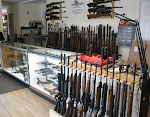Seeing is believing or believing is seeing? I was thinking about air gun suitable optics when I misplaced my reading glasses. It is becoming clear to me (even without my glasses) that there is much confusion about scoping air powered guns. And while I can pick up a pair of cheap readers at any supermarket you need to be mindful of a few things about scopes for air guns.
Nikko Stirling Diamond 10x50x60
The first documented telescopic rifle sight was invented between 1835 and 1840 by John Ratcliffe Chapman an engineer working with Morgan James. In 1855, William Malcolm, a telescope builder, used achromatic lenses and worked to make the windage and elevation adjustments more effective. His scopes were between 3X and 20X in power, these and ones made by Mr. L.M. Amidon of Vermont were used during the Civil War. Around 1880 August Fiedler (Stronsdorf), the forestry commissioner of the Prince of Reuss, built the first “modern” telescopic sight. This was followed by early commercial manufacture by Kahles, an Austrian company.
I cannot find any reference to the first marriage between air rifles and telescopic sights but the pre charged nature of the period guns seem to be a natural match. No smoke or powder residue! Lucky for us we have only to choose from the features we desire to add a scope to our modern airguns. So heres a couple of things you need to know about airgun scopes. Parallax pre set at air gun appropriate ranges or adjustable objective lenses to correct Parallax. If the scope is for a spring piston or gas ram rifle the scope should be rated for bi directional recoil. Here are a few of my favored air rifle scopes:
Bushnell: Banner 4-12x40 and Trophy 6-18x40 bright and clear optics, smooth focus and can be used on springers. I have had both these scopes on a R9 and Beeman airguns sells the R1 combo with a Banner 4-12x40.
Hawke: SR6 3-12x44. Innovative multi aim point, cross wind "correcting" and range estimating reticle. Ballistic Reticle Calculator (BRC) and Chair Gun ballistic computer program "programmable". I have one of these on my HW 100 T. Airmax 2-7x32 compact and featuring the MAP6 reticle which is also "programmable". I have one of these on my R7.
Nikko Stirling: Diamond 10-50x60, one of the most popular field target scopes. Side parallax adjustment. I have tried this scope on a couple of rifles and it is my first choice for extreme magnification. Suitable for astronomy (if you don't find MIL dots distracting).
Leapers: 3-9x32 full size, Value priced, tough as nails. Proven able to stand up to heavy recoiling springers and gas rams like Diana 48 and Beeman RX2.
Air gun scopes are one subject that a knowledgeable airgun shop can help you with. Making an ill conceived choice on a scope can be frustrating and costly. By the way, have you seen my glasses?
Rick Klages
Rick Klages










